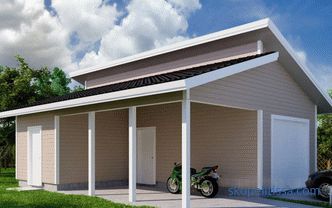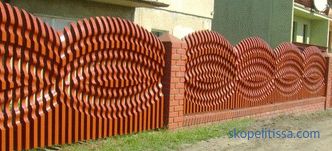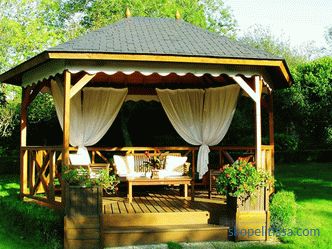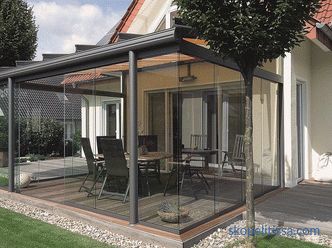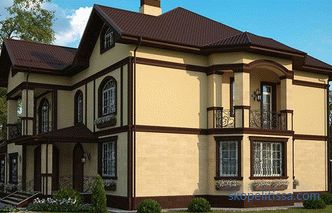
Unfortunately, the walls of houses often do not provide adequate insulation of the room. In order to reduce heat loss, during the finishing works additional insulation of buildings is used. Today, the range of methods and materials for cladding the facade is very wide, the most popular in our days is gaining such a technology of finishing and insulation, as wet facade .
Cottage according to the original project with insulation using wet facade technology.
What is the facade insulation?
There is d va of the main methods of external insulation of building walls:
- Dry or ventilated facade. The name of the technology was due to the fact that its installation does not use liquid adhesives, and there is no need to use plaster. Externally, this design is a frame hanging in a few centimeters from a wall on a special fastener, filled with heat insulating material.
- Wet facade , the design of which has no frame. Insulation here is mounted directly on the wall, several layers of plaster are applied on top of it, after which the finishing is completed with painting.
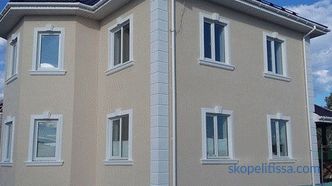 Photos of a private two-story building, insulated with a wet facade technology "width =" 700 "> Photos of a private two-story building, insulated with a wet facade technology.
Photos of a private two-story building, insulated with a wet facade technology "width =" 700 "> Photos of a private two-story building, insulated with a wet facade technology.
What is a "wet facade"?
The composition of a wet facade includes three layers:
- Thermal insulation layer - insulation boards glued to the main wall of the house
- Base layer is a special protective layer whose main task is to protect thermal insulation from environmental influences.
- Decorative coating is the third, inherent layer th for finishing the facade in a "wet" way.
The result of this three-layer finish is the solution of two problems at once: reliable thermal insulation and decoration of the building's appearance.
As insulation this technology uses facade foam or mineral wool in slabs.Fasteners are used to fasten heat insulation to the wall (dowels with hooks), as well as special glue (composition based on cement with the addition of mineral additives).
When choosing materials for finishing the wet facade of a particular building, specialists take into account several factors:
- number of floors;
- climatic features of the area;
- construction material houses.
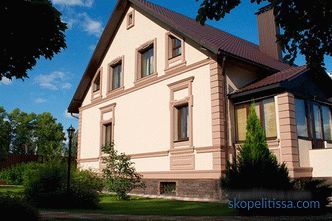
A small one-storey house with "wet facade" insulation.
The base layer consists of a reinforcing mesh and the same adhesive solution that is used to fix the insulation. It is on the base layer at the end of the work decorative decorative materials are attached.
Plaster is most often used as a decorative layer . This is explained by the simplicity and affordability of this type of finish. Also, it is important that it has a low weight, so that the whole structure does not exert a large load on the walls.
This method of warming is of a universal nature - it can be used for facades of multi-storey buildings and for thermal insulation of the walls of country houses.
It is possible to use the wet facade technology both for warming walls inside and outside the room. Exterior finish saves space, and also does not require any work in the house (there is no need for repairs in the room itself), so external insulation is used more often.
Advantages and disadvantages of the technology
The advantages of a wet facade include:
- simultaneous combination of the two main functions of exterior decoration - heat insulation and decoration;
- possibility of mounting on walls of various materials;
- increasing the sound insulation characteristics of the room, reducing the thermal conductivity of walls;
- increasing the life of the building;
- low cost;
- possibility of installation without the use of special construction equipment and heavy machinery.
The main disadvantage of a wet facade is inability to carry out installation work at air temperatures below 5C and high humidity.
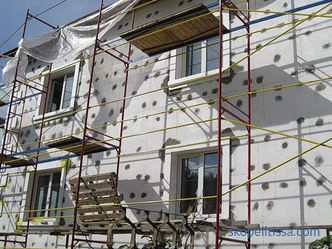
Installation of insulation plates using wet facade technology.
How is the installation of weatherization going on?
First you need to prepare the walls. Before finishing works, the walls must be cleaned, if necessary, remove the old coating, repair the cracks and level the surface.
After the preparatory activities have been carried out, proceed to the beginning of the direct installation of the facade.
The first step is to equip the basement profile. This profile serves as a protective barrier against moisture penetration to the bottom row of insulation. Next, is the laying of insulation material. The heater is fixed from bottom to top.The drying of the adhesive composition lasts about 3 days, then there is an additional fixation with dowels. The third stage is the installation of a reinforcing mesh. It is fixed on top of the insulation boards with an adhesive. After the reinforcing layer is completely dry, plaster is applied. The last stage is waterproofing the bottom of the facade.
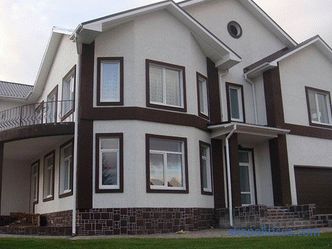
The original house, insulated with a "wet facade."
The cost of installation work
The cost of insulation using wet facade technology depends on the following factors:
- the number of window and door openings in the house;
- type of insulation and decorative finishing;
- building height;
- insulated facade area;
The average price for installation without materials is about 2500 rubles per 1 m 2 . The following types of work are usually included in the price:
- leveling the walls, priming the surface;
- gluing heat-insulating plates;
- installation of reinforcing mesh;
- plastering of the outer layer.
A large number of window and door openings, additional decorative elements increase the cost of installation.
Separate types of installation work on a wet facade and their cost (for 1 m 2 ) can be seen in the table:
| Type of work | Cost in rubles |
| Primer | starts from 50 |
| Alignment of the wall surface | from 650 |
| Installation of insulation plates | from 650 |
| Fastening of reinforcing mesh | from 250 |
| Leveling plaster layer | from 500 |
| Applying a decorative layer of plaster | from 650 |
| Installation of other facing materials | from 1200 |
It can easily be said that today the considered technology is one of the most popular, reliable and effective methods of building insulation. It allows you to simultaneously improve the insulating properties of the structure and give the building an aesthetic appearance, without requiring large financial costs.
Rate this article, we tried for you
